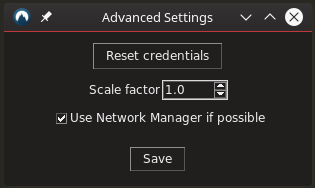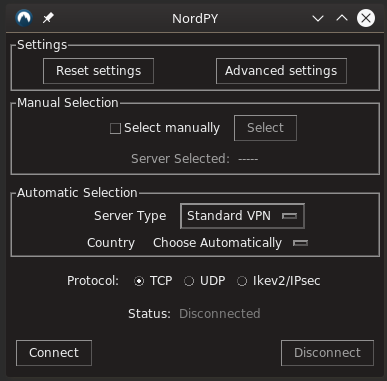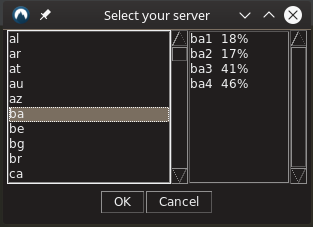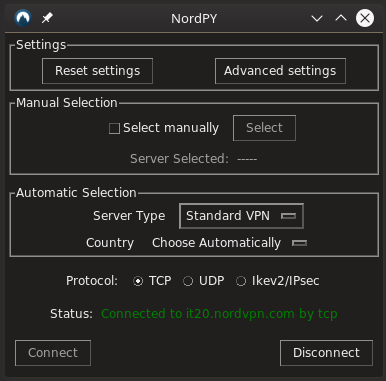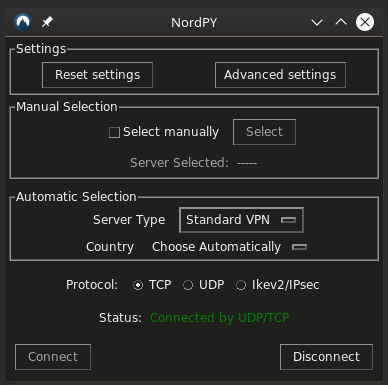A python application with gui to connect automatically to the recommended NordVPN server (as of NordVPN site) of a certain type, in a certain country or to the specific chosen server (stats for each server are shown in the relative window).
All server types on NordVPN site are available to be selected in the window.
KDE Plasma users can also find the relative plasmoid.
Tested against DNS leaks (NetworkManager use is discouraged (and disabled by default) as it may leak DNS)
NOTE : ikev2 support is tested on Debian, Arch and derivatives (if something's not right button won't show up)
- Automatic connection to recommended server (according to nordvpn.com)
- TCP, UDP and IKEv2/IPsec protocols are available
- Connection (TCP and UDP) can be established with either
openvpnorNetworkManager-openvpn(will show connection in the system interface) - No DNS leak (when using
openvpn) - Killswitch (when using
openvpn) - Quick connection/disconnection from command line (according to last chosen server type)
- Easy to setup for autoconnection at startup
- Integrated with its own plasmoid
Arch Linux users can find this project on the AUR.
For Debian/Ubuntu, Fedora/Red Hat users:
To install all dependencies, download config files and to add a desktop entry in the main menu just run install.sh
For other distros:
install the following packages:
python3 python3-tk python3-requests openvpn wget unzip net-tools iproute2
and
strongswan libstrongswan-standard-plugins libstrongswan-extra-plugins libcharon-extra-plugins
to support ikev2 (facultative)
networkmanager-openvpn
to support Network Manager (facultative).
Then run install.sh
If you have a dual monitor setup you may also want to install screeninfo (pip3 install --user screeninfo) to correct window centering.
At the launch of the installation script you will be asked
Do you want to install support for obfuscated servers (it will reinstall openvpn)?[y/n] (Recommended: n)
if you answer is y then openvpn will be built from source (version 2.4.4) applying patch for obfuscation. If you do not run Debian/Ubuntu, Fedora or Arch, you should provide the following packages and then run install.sh
automake autoconf perl gnupg quilt libtool openssl-devel lzo-devel pam-devel net-tools
Note: Installing support for obfuscated servers breaks Network Manager openvpn support in some distros (in that case you should disable it in the advanced options)
Open the application, select your preferred server type (also manually) and protocol and just press connect. Once you are connected you can even close the application and reopen it when you want to disconnect the VPN. If the size of the window does not fit entirely the gui components change the scale factor in the advanced settings.
nordpy can be called with 3 different commands (in this case the gui isn't opened):
--quick-connectstarts a connection according to the last chosen preferences (you must first start a connection using the gui)--quick-disconnectshuts down any connection thatnordpypreviously started--statuschecks if any VPN is already running
All options can be listed with nordpy --help
You can easily configure nordpy to establish VPN connection at the start of your system. You just need to
- Install a cron implementation (I usually use
cronie) - Edit the root crontab (
sudo crontab -e) and add the following line to it
@reboot PATH/TO/nordpy.py --quick-connect --wait-connection
(you can easily obtain your path to nordpy with which nordpy).
You can disable it just by deleting the line you added to the crontab.
When pressed "Select":
After connection has been established:
Before running the tests you need to install needed dependencies with
# pip install -r tests/requirements.txt
Make sure you also connected at least once with the gui (in order to store the credentials). Then tests can be started with
$ python -m pytest tests
You can also easily setup a test environment with vagrant (so you will need to install before proceeding with the following steps): the project contains a minimalistic Vagrantfile to initialize it.
-
Start the
nordpygui and connect to any server in order to store the password -
Change the permissions of the
credentialsfile. WARNING: this will the expose the password of your NordVPN account to anyone which has access to your machine.
# chmod +r credentials
- Create the environment
$ vagrant up
- Open a shell into the vm
$ vagrant ssh
- Move to the shared folder and install nordpy
$ cd /Vagrant && ./install.sh
- Start testing as said above!



